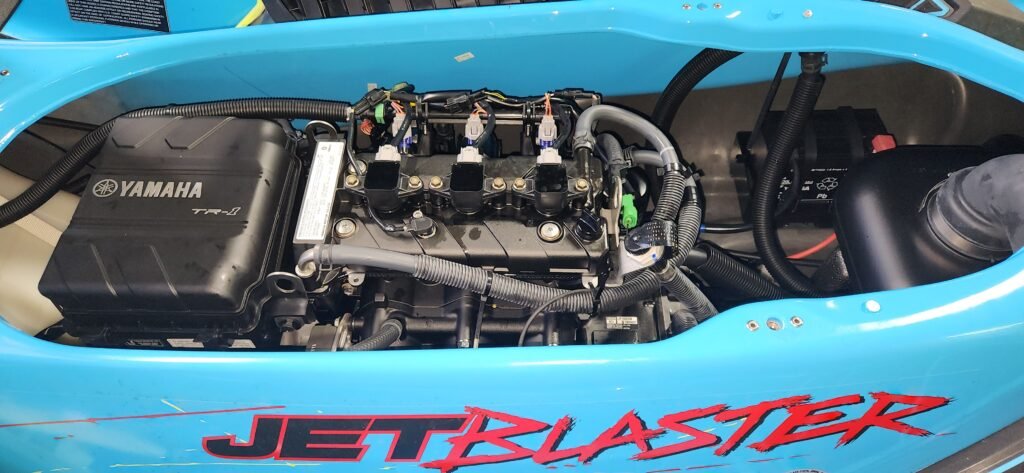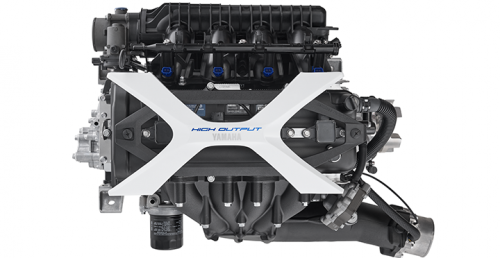This post may contain affiliate links, which means that I may make a small commission off items you purchase at no additional cost to you. Please see my terms of use page for details.
Are you curious about the type of engine that powers Yamaha’s jetskis? Well, you’re in luck! In this article, we will delve into the fascinating world of watercraft engines and explore the specific type of engine that Yamaha utilizes in their jetskis. Whether you’re an avid jetski enthusiast or simply interested in learning more about these thrilling machines, join us as we uncover the technical details and unique features of Yamaha’s engines. Get ready to be captivated by the power and precision that propels these exhilarating water vehicles through the waves!
Introduction to Yamaha Jetski Engines
When it comes to jetskis, Yamaha is a brand that is known for its exceptional performance, reliability, and innovation. One of the key factors behind Yamaha’s success lies in the engines they use in their jetskis. Yamaha offers a range of engine options designed to cater to different needs and preferences. In this article, we will explore the various types of engines Yamaha uses in their jetskis, the advantages and disadvantages of each, and delve into their engines technology innovations. We will also discuss maintenance and servicing tips for Yamaha jetski engines, as well as provide information on authorized service centers and warranty details.

Yamaha 4-Stroke Engines
Yamaha jetskis are renowned for their powerful and efficient 4-stroke engines. These engines are designed to provide a smooth and enjoyable riding experience while prioritizing fuel efficiency and environmental friendliness. One of the main benefits of Yamaha 4-stroke engines is their quiet operation, making them ideal for riders who prefer a more peaceful ride. These engines also offer improved low-end torque, allowing for quick acceleration and excellent performance.
Benefits of Yamaha 4-Stroke Engines
Yamaha 4-stroke engines offer several advantages that make them a popular choice among jetski enthusiasts. Firstly, their fuel efficiency is commendable, allowing riders to enjoy longer rides without worrying about running out of fuel. Additionally, these engines produce lower emissions, contributing to a cleaner and more sustainable ride. Another notable benefit is the reduced maintenance requirements of Yamaha 4-stroke engines, which translates to more time on the water and less time in the garage.

Performance Characteristics of Yamaha 4-Stroke Engines
In terms of performance, Yamaha 4-stroke engines excel in delivering a smooth and powerful ride. These engines boast impressive acceleration, ensuring an exhilarating experience on the water. The torque provided by these engines guarantees excellent handling and maneuverability, allowing riders to carve through waves with ease. The reliability of Yamaha 4-stroke engines is also worth mentioning, as they are built to withstand the demanding conditions of jetski riding.
Yamaha 2-Stroke Engines
While Yamaha primarily focuses on 4-stroke engines, they also offer 2-stroke engines for jetski enthusiasts. 2-stroke engines have their own unique set of advantages and disadvantages compared to their 4-stroke counterparts. It is essential to consider these factors when deciding on the engine type that suits your needs and preferences.

Advantages and Disadvantages of Yamaha 2-Stroke Engines
Yamaha 2-stroke engines offer some notable advantages. They are typically lighter in weight compared to 4-stroke engines, resulting in enhanced maneuverability and agility on the water. These engines also tend to have a higher power-to-weight ratio, providing an adrenaline-pumping experience for riders who crave speed and agility. However, 2-stroke engines generally consume more fuel and produce higher emissions than their 4-stroke counterparts. They also require a mixture of oil and gas for proper lubrication, which adds an extra step to the refueling process.
Notable Models Featuring Yamaha 2-Stroke Engines
Yamaha has incorporated 2-stroke engines in some of their notable jet ski models. The Original Yamaha SuperJet, a high-performance stand-up jetski, is equipped with a Yamaha 2-stroke engine. This model appeals to thrill-seekers and professional riders who enjoy the excitement and agility of stand-up jet skiing. It showcases the power and capabilities of Yamaha’s 2-stroke engines in delivering a thrilling and exhilarating ride.
Yamaha Supercharged Engines
Yamaha also offers supercharged engines in their jet skis, taking performance to a whole new level. These engines are specifically designed for riders who crave exceptional speed and acceleration. The incorporation of supercharger technology allows Yamaha to deliver an adrenaline-fueled experience that will leave riders breathless.
Features and Benefits of Yamaha’s Supercharged Engines
Yamaha’s supercharged engines are equipped with advanced technology to provide maximum power and performance. The supercharger compresses the air entering the intake and combustion chamber, resulting in increased air and fuel mixture, ultimately leading to enhanced power output. This technology enables riders to reach exhilarating speeds and experience unmatched acceleration. Yamaha’s supercharged engines also excel in delivering consistent performance across a wide range of riding conditions and water surfaces.
Performance Capabilities of Yamaha Supercharged Engines
Yamaha’s supercharged engines showcase impressive performance capabilities, allowing riders to push the limits of speed and agility. These engines provide instant throttle response, ensuring rapid acceleration and heart-pounding rides. The top-speed capabilities of Yamaha’s supercharged engines are truly impressive, making them a top choice for riders and racers seeking the ultimate thrill on the water. The sophisticated engineering and design of these engines ensure a reliable and exhilarating riding experience.
Yamaha Engine Technology Innovations
Yamaha is continuously striving to push the boundaries of engine technology in the world of jet skis. They have introduced several innovations and advancements that set their engines apart from the competition. Let’s explore some of Yamaha’s notable engine technology innovations.
Yamaha’s Exclusive High-Output Engine
Yamaha’s High-Output Engine is a state-of-the-art technology that focuses on optimizing power and performance. These engines are meticulously designed to deliver impressive acceleration and top speeds, catering to riders who crave adrenaline-pumping experiences. The High-Output version offers exceptional torque and throttle response, ensuring precise control and maneuverability on the water. Yamaha’s commitment to innovation is clearly demonstrated through the development of their exclusive High-Output Engine.

Exploring Yamaha’s NanoXcel Hull and Superstructure
Powerful engines are only part of the equation when it comes to exceptional jet ski performance. Yamaha’s NanoXcel hull and superstructure technology contribute to the overall riding experience. This innovative technology utilizes lightweight materials that enhance the strength and rigidity of the hull, resulting in improved stability and maneuverability. The NanoXcel technology not only reduces the weight of the jet ski but also contributes to fuel efficiency and handling capabilities.
Yamaha Engine Maintenance and Servicing
Proper maintenance and servicing are crucial for ensuring the longevity and reliability of Yamaha jetski engines. To help you keep your engine running smoothly, let’s discuss some essential tips for maintaining Yamaha jet ski engines.
Tips for Maintaining Yamaha Jetski Engines
Regularly change the engine oil and oil filter according to the recommended intervals outlined in your owner’s manual. Maintain proper fuel levels and use high-quality fuel to optimize engine performance and prevent fuel system issues. Inspect the engine’s cooling system regularly to ensure proper circulation and prevent overheating. Clean and lubricate moving parts, such as throttle cables and steering components, to maintain smooth operation. Perform routine inspections of spark plugs and hoses to identify and address any signs of wear or damage promptly. Store your jet ski in a dry and secure location, away from direct sunlight and extreme temperature fluctuations, to prevent damage during periods of non-use.
Yamaha Authorized Service Centers and Warranty Information
Yamaha has a network of authorized service centers that specialize in maintaining and servicing Yamaha jet ski engines. It is highly recommended to rely on these certified professionals for any complex repairs or maintenance tasks. Additionally, Yamaha provides warranty coverage for their jetski engines, offering peace of mind to owners. Familiarize yourself with the warranty terms and conditions to ensure that you can take full advantage of the support provided by Yamaha.
In conclusion, Yamaha jetskis are equipped with high-quality engines designed to deliver exceptional performance, reliability, and innovation. Whether you choose a 4-stroke engine for fuel efficiency and smooth operation, a 2-stroke version for exhilarating speed, or a supercharged model for the ultimate adrenaline rush, Yamaha has an engine option to suit your preferences. With their commitment to continuous innovation and emphasis on engine technology, Yamaha remains at the forefront of the jetski industry. By following proper maintenance practices and utilizing authorized service centers, you can ensure that your Yamaha jetski engine will provide you with countless hours of thrilling and enjoyable rides on the water.
Related Articles:
How Well Does A Yamaha Jetski Hold Its Value Compared To Other Brands?
Experience the Ultimate Rush: 2022 Yamaha Jet Blaster Review
